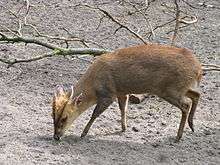Reeves's muntjac
| Reeves's muntjac | |
|---|---|
 | |
| Scientific classification | |
| Kingdom: | Animalia |
| Phylum: | Chordata |
| Clade: | Synapsida |
| Class: | Mammalia |
| Order: | Artiodactyla |
| Family: | Cervidae |
| Subfamily: | Cervinae |
| Genus: | Muntiacus |
| Species: | M. reevesi |
| Binomial name | |
| Muntiacus reevesi (Ogilby, 1839) | |
Reeves's muntjac (Muntiacus reevesi; Chinese: 山羌) is a muntjac species found widely in southeastern China (Gansu to Yunnan) and in Taiwan.[2] It has also been introduced in Belgium, the Netherlands, the United Kingdom (south England,[3][4] the Midlands,[4] and east Wales[4]) and Ireland by 2008.[5] It feeds on herbs, blossoms, succulent shoots, grasses and nuts, and was also reported to eat trees.[4] It takes its name from John Reeves, who was appointed Assistant Inspector of Tea for the British East India Company in 1812.
Description
This muntjac grows to 0.5 metres (1 ft 8 in) high at the shoulder,[6] 0.95 m (3 ft 1 in) in length, and weighs between 10 and 18 kilograms (22 and 40 lb) when fully grown. It is dog-like in appearance but has striped markings on its face.[6] The male has short antlers,[6] usually four inches or less, and uses them to push enemies off balance so he can wound them with his upper two inch canine teeth. The Taiwanese subspecies (M. r. micrurus), commonly known as the Formosan Reeves' Muntjac, is relatively dark compared to the other subspecies.
Reeves's muntjac is also called the barking deer, known for its distinctive bark,[4] though this name is also used for the other species of muntjacs.

Reproduction
Female muntjacs (known as "does"[7]) become sexually mature within the first year of life. Mating occurs throughout the year. Gestation period lasts from 209 to 220 days.[8] Females limit the number of mating bouts, though time between successive bouts is determined by males[9] (known as "bucks"[7]).
Introduction into UK
An unspecified species of muntjac was introduced to the grounds of Woburn Abbey in Bedfordshire in the nineteenth century by the then Duke of Bedford. While a small number are reported as escaping, it is extremely unlikely that they are the source of the current UK population. Larger numbers of muntjac escaped from Whipsnade Zoo, and they are the more likely ancestors, in addition to other releases.
Since the Wildlife and Countryside Act 1981, it has been illegal to release the species except where already established. Reeves's muntjac colonies exist throughout England south of Derbyshire, and the population continues to grow. In Ireland, the first sightings of muntjac in 2008 caused the Government, concerned at the risk of the species becoming established, to quickly introduce an all year round hunting season.
Conservation
In Hong Kong, it is a protected species under Wild Animals Protection Ordinance Cap 170. Overall though it generally remains common and widespread, resulting in it being listed as Least Concern by the IUCN.[1]
References
- 1 2 Leasor, H.; P. J. Chiang & K. J.-C. Pei (2008). "Muntiacus reevesi". IUCN Red List of Threatened Species. Version 2011.2. International Union for Conservation of Nature. Retrieved 5 April 2009.
- ↑ Wilson, D.E.; Reeder, D.M., eds. (2005). Mammal Species of the World: A Taxonomic and Geographic Reference (3rd ed.). Johns Hopkins University Press. ISBN 978-0-8018-8221-0. OCLC 62265494.
- ↑ http://www.hows.org.uk/inter/birds/exotics/emam.htm
- 1 2 3 4 5 David Derbyshire (March 22, 2010). "Have you seen this dangerous deer which threatens to wreak havoc on our native wildlife?". Daily Mail. p. 13. Retrieved March 22, 2010.
- ↑ Sleeman, D.P. and Carlsson, J. Introduction in Sleeman, D.P., Carlsson, J. and Carlsson, J.E.L. (eds) 2014. Mind the Gap 11.: new insights into the Irish postglacial. Ir Nat J. ISBN 978-0-9569704-8-0
- 1 2 3 "Muntjac, Muntiacus reevesi". GB Non-native species secretariat. DEFRA.
- 1 2 "Muntjac (Muntiacus reevesi)". www.bds.org.uk. The British Deer Society. Retrieved 13 March 2014.
- ↑ Whitehead, Kenneth (1993). The Whitehead Encyclopedia of Deer. Stillwater, MN: Voyager Press. p. 597.
- ↑ Yahner, Richard (August 1979). "Temporal Patterns in Male Mating Behavior of Captive Reeve's Muntjac (muntiacus Reevesi)". Journal of Mammalogy. 3. 60: 560–567. doi:10.2307/1380097.
External links
 Media related to Muntiacus reevesi at Wikimedia Commons
Media related to Muntiacus reevesi at Wikimedia Commons
